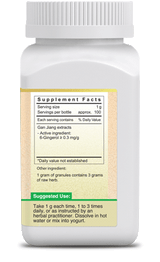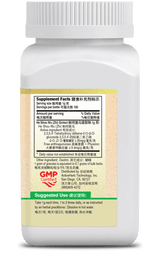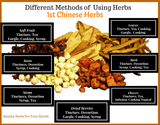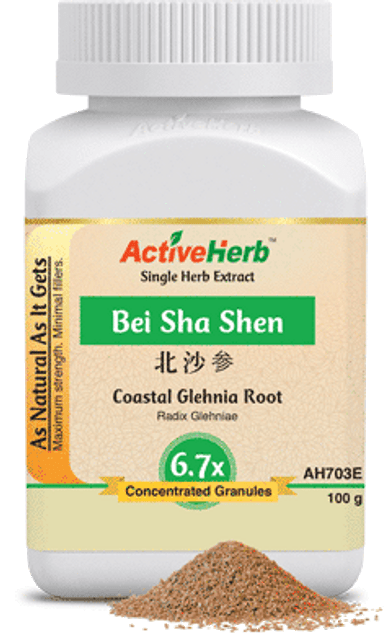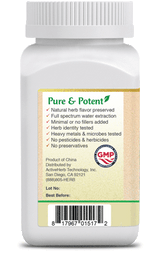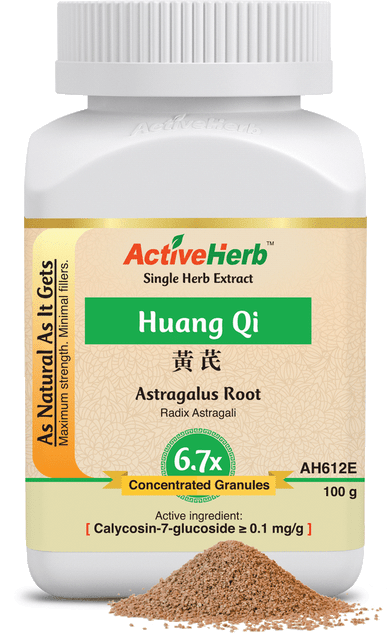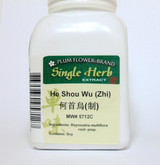erbal Information for He Shou Wu Zhi 6.7X Concentrated Granules
Common Names: Fo-ti Cured Root Tuber
Botanical Name: Polygonum multiflorum
Pin Yin Name: He Shou Wu (Zhi)
Other Names: Dried Fallopia Multiflora, Chinese Knotweed, Fallopia Multiflora, Fo Ti, Polygala Vine, Tuber Fleeceflower Root
Granule Composition: 80% extract + 20% dextrin
Package Size: 100 grams Extract granules
Form: 6.7X Concentrated Granules
Active Ingredients: Tetrahydroxy stilbene-2-Ο-β-D-glucoside, 25 mg / g. Free anthraquinones + Physcion, 0.4 mg / g
Dosage: Take 1 g each time, 1 time per day, or as instructed by a herbal practitioner. Dissolve in hot water or mix into yogurt. Consult your healthcare professional for correct dosage.
Origin: China
Brand: ActiveHerb Single Herb Extract
Channels: Liver, Heart, Kidney
Property: Bitter, sweet, astringent, warm
Caution: Do not use if pregnant or nursing. Do not use in large doses. Overdosing may cause abdominal pain, diarrhea, and dry mouth
 Benefits of He Shou Wu (Zhi)
Benefits of He Shou Wu (Zhi)
- Aids in tonifying the liver and kidneys
- Promotes in nourishing the blood and augmenting jing
- Aids in strengthening bones and tendons.
- Supports sexual health
- Anti-Aging Properties: He Shou Wu is often associated with anti-aging effects and is believed by some to promote longevity and vitality.
- Hair Health: One of the traditional uses of He Shou Wu is to promote hair health and prevent premature graying.
- Libido and Fertility: He Shou Wu is sometimes used to support reproductive health
- Tonify the kidneys and improve overall vitality, potentially benefiting libido and fertility.
- Energy and Stamina: Some people use He Shou Wu as an energy tonic.
- Adaptogenic Properties: He Shou Wu is considered an adaptogen, a substance that may help the body adapt to stress and restore balance.
He Shou Wu, also known as Fo-Ti or Polygonum multiflorum, is a herb that is native to China. It has been used for centuries in traditional Chinese medicine for its purported health benefits. The Chinese name "He Shou Wu" translates to "Mr. He's black hair," referencing a legend about a man named He who restored his vitality, youth, and dark hair color by regularly consuming the herb.
He Shou Wu is commonly used as a tonic for the liver and kidneys and is believed to have various health-promoting properties, including anti-aging effects, improved fertility, and enhanced energy. It is often promoted for its potential to support hair health and may be included in herbal formulas or supplements aimed at promoting hair growth and preventing premature graying.
He Shou Wu is widely used in Chinese herbalism as a tonic to promote healthy aging by tonifying the kidney and liver functions, toning up Jing, vital essence, and nourishing the blood.
Constituents: He Shou Wu contains zinc. Zinc is an essential trace mineral required by all forms of life. Numerous aspects of cellular metabolism are zinc–dependent. Zinc plays important roles in growth and development, the immune response, neurological function and reproduction. Zinc is important to our sexual and reproductive functions.
Key constituents found in He Shou Wu:
Stilbene Glycosides: These are compounds with antioxidant properties. One specific stilbene glycoside found in He Shou Wu is resveratrol, which is also found in red wine and has been studied for its potential health benefits.
Anthraquinones: These compounds are known for their laxative effects and may contribute to the herb's traditional use for promoting digestive health.
Phospholipids: He Shou Wu contains phospholipids, which play a role in the structure and function of cell membranes.
Triterpenes: Triterpenes are compounds that are found in plants and have been studied for their potential anti-inflammatory and antioxidant effects.
Phosphatides: These are phospholipids that are crucial for the structure and function of cell membranes.
Polyphenols: He Shou Wu contains polyphenolic compounds, which have antioxidant properties and may help protect cells from oxidative stress.
Iron: He Shou Wu is a source of iron, which is an essential mineral for various bodily functions, including the transport of oxygen in the blood.
Unsure of what the term rhizome means? View are parts of plants - Rhizome Anatomy
How to Use Different Types of Herbs
References:
https://urbol.com/he-shou-wu/
https://www.ncbi.nlm.nih.gov/pmc/articles/PMC4471648/
http://www.itmonline.org/arts/hsw_alert.htm
https://losrobleshospital.com/hl/?/21716/He-Shou-Wu
https://www.ncbi.nlm.nih.gov/pmc/articles/PMC5288971/
https://herbpathy.com/Uses-and-Benefits-of-Polygonum-Multiflorum-Cid601


